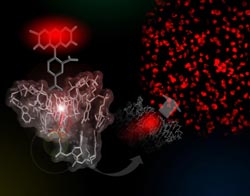Chemistry: Success Through Cooperation

A fluorescent dye lightens up the modified RNA in the cell. Uni Innsbruck<br>
The results of the close cooperation of two research groups of the Centre for Molecular Biosciences (CMBI) have been published in the journal ACS Chemical Biology.
In biosciences RNA interference has become one of the major tools for analyzing gene function. By using short strands of RNA molecules, scientists can target specific genes in the genome and silence them, which enables the researchers, for example, to determine their biological function in the cell. High expectations have also been placed on this tool to develop new pharmacological therapies to treat diseases. To successfully use RNA in this context, it usually has to be modified chemically. This protects the molecule from degradation processes in the cell, decreases off-target effects and prevents immune reactions. Numerous chemical modifications have been developed and tested since RNA interference was discovered. However, a simple modification of RNA molecules had previously been neglected: coupling an azido group to the molecule. A team of chemists led by Ronald Micura from the Institute of Organic Chemistry and Klaus Bister from the Institute of Biochemistry, University of Innsbruck, together with Eric Ennifar, specializing in crystallography at the University of Strasbourg, have tested this chemical modification successfully for the first time.
Modified chemically, same effect biologically
“This modification has been neglected because it cannot be synthesized with the standard method,“ explains Ronald Micura. “Now we have found a way, which is based on standard procedures, to couple the azido group to the RNA.“ After determining its three dimensional crystal structure at the University of Strasbourg, Klaus Bister’s research group tested the biological function of the modified RNA. “In our experiment we used an RNA molecule that specifically suppresses the gene BASP1,” says Bister. “We have been investigating this gene intensively for a while now because it plays an important role in cancer growth and so this project is of very high interest for us.“ Biological analyses in Innsbruck showed that the chemical modification of the RNA did not affect its biological function. “This is very important for its future application,“ explains Katja Fauster, first author of the publication. “Another advantage is that the modification is reactive, which means that we can add additional molecules to the azido group.” The chemists exploited this reactivity in the experiment to lighten up the RNA in the cell by introducing fluorescent dyes.
New building – new communication networks
The two research groups headed by Bister and Micura, who just settled in to the new building called Centrum for Chemistry and Biomedicine (CCB), underline the success of interdisciplinary cooperation within the main research Centre of Molecular Biosciences (CMBI) at the University of Innsbruck. “The only thing that separates us today is a flight of stairs,” says Klaus Bister, who is very happy about the new working and research conditions in the new building. The communicative design of the new building promises an increase in successful joint projects within the main research area. The Innsbruck researchers are supported by the Austrian Science Fund FWF and within the framework of the GEN-AU research program funded by the Ministry of Science.
Weitere Informationen:
http://dx.doi.org/10.1021/cb200510k – 2′-Azido RNA, a Versatile Tool for Chemical Biology: Synthesis, X-ray Structure, siRNA Applications, Click Labeling. Katja Fauster, Markus Hartl, Tobias Santner, Michaela Aigner, Christoph Kreutz, Klaus Bister, Eric Ennifar, Ronald Micura. ACS Chem. Biol., 2012, 7 (3), pp 581-9
http://www.uibk.ac.at/cmbi/ – Center for Molecular Biosciences (CMBI)
Contact:
Univ.-Prof. Dr. Klaus Bister
Institute of Biochemistry
University of Innsbruck
phone: +43 512 507 57500
email: klaus.bister@uibk.ac.at
Univ.-Prof. Dr. Ronald Micura
Institute of Organic Chemistry
University of Innsbruck
phone: +43 512 507 57710
email: ronald.micura@uibk.ac.at
Dr. Christian Flatz
Büro für Öffentlichkeitsarbeit
University of Innsbruck
phone: +43 512 507 32022
email: christian.flatz@uibk.ac.at
Media Contact
More Information:
http://www.uibk.ac.at/cmbi/All latest news from the category: Life Sciences and Chemistry
Articles and reports from the Life Sciences and chemistry area deal with applied and basic research into modern biology, chemistry and human medicine.
Valuable information can be found on a range of life sciences fields including bacteriology, biochemistry, bionics, bioinformatics, biophysics, biotechnology, genetics, geobotany, human biology, marine biology, microbiology, molecular biology, cellular biology, zoology, bioinorganic chemistry, microchemistry and environmental chemistry.
Newest articles

Properties of new materials for microchips
… can now be measured well. Reseachers of Delft University of Technology demonstrated measuring performance properties of ultrathin silicon membranes. Making ever smaller and more powerful chips requires new ultrathin…

Floating solar’s potential
… to support sustainable development by addressing climate, water, and energy goals holistically. A new study published this week in Nature Energy raises the potential for floating solar photovoltaics (FPV)…

Skyrmions move at record speeds
… a step towards the computing of the future. An international research team led by scientists from the CNRS1 has discovered that the magnetic nanobubbles2 known as skyrmions can be…





















